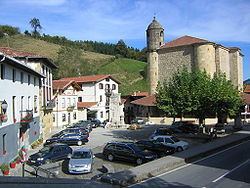Time zone CET (UTC+1) Area 18.5 km² Local time Sunday 3:20 AM | Autonomous community País Vasco Founded 2005 Elevation 150 m Population 434 (2014) | |
 | ||
Demonym(s) Ziortzarra Bolibartarra Weather 9°C, Wind W at 19 km/h, 90% Humidity | ||
Kulturgunearen eta beko zubiko parkearen inaugurazioa ziortza bolibar
Ziortza-Bolibar (Spanish: Cenarruza-Puebla de Bolívar) is a municipality in the province of Biscay, Basque Country (Spain), in the comarca of Lea-Artibai. It has 383 inhabitants according to the 2006 census, and has an area of 18.94 km².
Contents
- Kulturgunearen eta beko zubiko parkearen inaugurazioa ziortza bolibar
- Map of 48279 Ziortza Bolibar Biscay Spain
- Korrika 18 ziortza bolibar
- Etymology
- Puebla de Bolvar
- The Collegiate Church of Cenarruza
- Other monuments in Bolvar
- References
Map of 48279 Ziortza-Bolibar, Biscay, Spain
The municipality was annexed in 1969 by Markina-Xemein and recovered its independence on January 1, 2005. Records indicate its existence since the 11th century.
Korrika 18 ziortza bolibar
Etymology
The name Bolibar comes from the Basque language, meaning "windmill valley" (bolu = "windmill" and ibar = "valley"). Ziortza/Cenarruza is derived from a local name for polygonum ziaurri (historically *zinaurri) and the suffix -tza denoting a place of abundance of something.
Puebla de Bolívar
Bolívar or Bolibar (in Basque) is the urban centre of the municipality, situated along the stream with the same name, at the foot of Mount Oiz.
From 1969 to 2004 it belonged, along with the neighbourhood of Cenarruza (Ziortza in Basque), to the municipality of Markina-Xemein, until a community movement managed to merge both neighbourhoods into an independent municipality.
The last name Bolívar has its origins in this locality; Simón Bolívar de la Rementería, a colonist born in this neighbourhood, took it from Europe to the America, where his famous descendant Simón Bolívar, one of the Liberators of America made it famous around the world. There are a couple of statues and a museum in his honour; there was a family house in Rementería, behind the local church, but it does not exist anymore.
Other illustrious people from this small village are: Diego de Irusta, who participated in the Battle of Las Navas de Tolosa; the abbots of the Collegiate church of Cenarruza; Diego and Bernardino de Irusta; general Francisco de Longa, hero of the Spanish Independence War; and general Pedro de Zubiaur.
The Collegiate Church of Cenarruza
The Collegiate Church of Cenarruza or Ziortza is located roughly two kilometers from the urban nucleus. It was an important enclave in the Route of Santiago de Compostela, and its influence extended beyond the comarca and surpassed the religious scope.
Tradition marks its founding in the 10th century. According to legend, on the day of the Assumption in the year 968 the local inhabitants held a mass in the Church of Santa Lucia de Garay, when an eagle picked up a skull from an opened tomb and dropped it in the place where the Collegiate Church is situated today. The people understood this event to be a sign and raised the religious complex in that place.
The complex consists of:
There was a hospital for pilgrims that was destroyed in a fire and was subsequently rebuilt as a hostel managed by Cistercian monks and is the property of the monastery of Oliva in Navarra. There are remains of a walkway which formed part of the Santiago Route.
